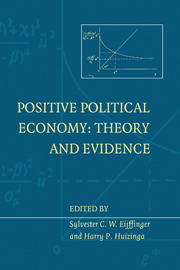Book contents
- Frontmatter
- Contents
- List of figures
- List of tables
- List of contributors
- Foreword
- Introduction
- I Monetary institutions and policy
- 1 Reputational versus institutional solutions to the time-consistency problem in monetary policy
- 2 Reciprocity and political business cycles in federal monetary unions
- 3 The ultimate determinants of central bank independence
- 4 Central bank autonomy and exchange rate regimes – their effects on monetary accommodation and activism
- 5 Uncertainty, instrument choice, and the uniqueness of Nash equilibrium: microeconomic and macroeconomic examples
- 6 New empirical evidence on the costs of European Monetary Union
- II Exchange rate policy and redistribution
- Index
3 - The ultimate determinants of central bank independence
from I - Monetary institutions and policy
Published online by Cambridge University Press: 05 September 2013
- Frontmatter
- Contents
- List of figures
- List of tables
- List of contributors
- Foreword
- Introduction
- I Monetary institutions and policy
- 1 Reputational versus institutional solutions to the time-consistency problem in monetary policy
- 2 Reciprocity and political business cycles in federal monetary unions
- 3 The ultimate determinants of central bank independence
- 4 Central bank autonomy and exchange rate regimes – their effects on monetary accommodation and activism
- 5 Uncertainty, instrument choice, and the uniqueness of Nash equilibrium: microeconomic and macroeconomic examples
- 6 New empirical evidence on the costs of European Monetary Union
- II Exchange rate policy and redistribution
- Index
Summary
Introduction
Recently, in many countries both political and monetary authorities have shown an increasing interest in the objective of monetary stability and the position of the central bank. As pointed out by Persson and Tabellini (1993), recent policy reforms and historical experience suggest two different routes to price stability.
The first way is the legislative approach, namely to create by law a very independent central bank with an unequivocal mandate to focus on price stability. Interest in this approach is motivated by the success of the Deutsche Bundesbank in maintaining one of the lowest rates of inflation for several decades. Moreover, the accepted statute of the European Central Bank is strongly influenced by the law governing the Bundesbank. Moreover, France and Spain have reformed their central bank laws making the Banque de France and the Banco de España more independent of government. Furthermore, countries in Central and Eastern Europe, such as the Czech Republic, Hungary, and Poland, have increased the legal independence of their central banks. Finally, in Latin America there are also tendencies toward granting more independence to the central banks in Argentina, Chile, Mexico, and Venezuela. Academic contributions in this area are Rogoff (1985), Neumann (1991), and Lohmann (1992).
The second way is the targeting or contracting approach, namely to let the political principal of the central bank impose an explicit inflation target for monetary policy, and make the central bank governor explicitly accountable for his success in meeting this target.
- Type
- Chapter
- Information
- Positive Political EconomyTheory and Evidence, pp. 47 - 74Publisher: Cambridge University PressPrint publication year: 1998
- 6
- Cited by



